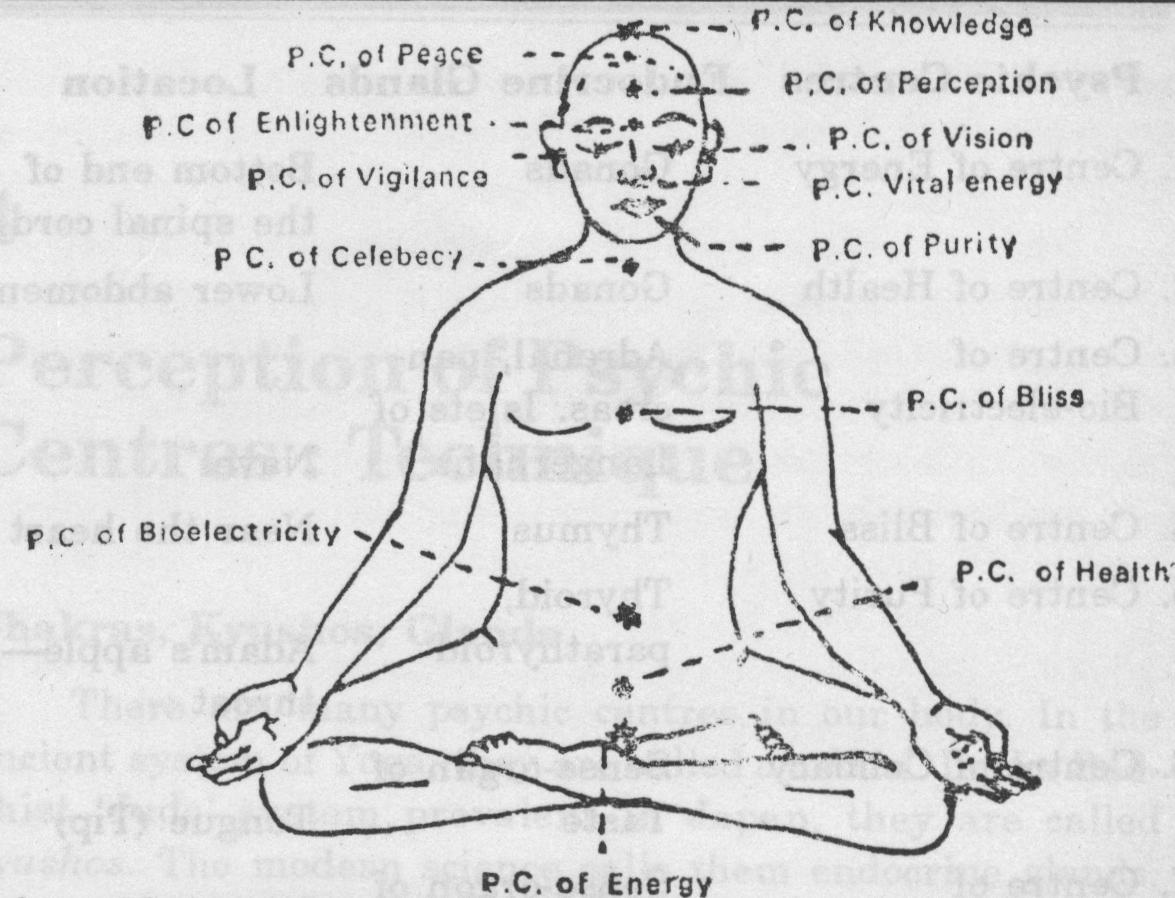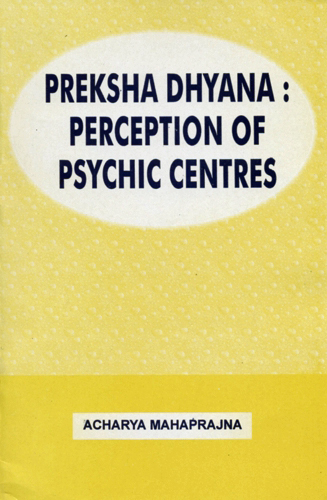Chakras, Kyushos, Glands
There are many psychic centres in our body. In the ancient system of Yoga, they are called chakras. In the Buddhist 'Judo' system prevalent in Japan, they are called kyushos. The modern science calls them endocrine glands. It is astonishing that the location of these centres and their physical properties are very similar with minor differences in all these disciplines. The following table gives the names of these centres in all the three systems:
| Chakras (Yoga) | Kyushos (Judo) | Glands | |
|---|---|---|---|
| 1. | Sahasrãra | Tendo | Pineal |
| 2. | Ãjñã | Uto | Pituitary |
| 3. | Višuddhi | Hichu | Thyroid |
| 4. | Anãhat | Kyotosty | Thymus |
| 5. | Manipúra | Suigestu | Adrenal |
| 6. | Svãdhisthãna | Myojo | Gonads |
| 7. | Múlãdhãra | Tsurigane | Gonads |
Psychic Centres (Chaitanya Kendras)
In the PREKSHA system, psychic centres (Chaitanya Kendras) correspond to the chakras and glands. The following table shows the psychic centres, their location in the body and their association with the endocrine glands or sense-organs:
| Psychic Centres | Endocrine Glands | Location | |
|---|---|---|---|
| 1. | Centre of Energy | Gonads | Bottom end of the spinal cord. |
| 2. | Centre of Health | Gonads | Lower abdomen |
| 3. | Centre of Bio-electricity | Adrenal, pancreas. Islets of Langerhans | Navel |
| 4. | Centre of Bliss | Thymus | Near the heart |
| 5. | Centre of Purity | Thyroid, parathyroid | Adam's apple - throat |
| 6. | Centre of Celibacy | Sense-organ of Taste | Tongue (Tip) |
| 7. | Centre of Vital Energy | Sense-organ of Smell | Nose (Tip) |
| 8. | Centre of Vision | Sense-organ of Sight | Eyes |
| 9. | " " Vigilance | Sense-organ of Hearing | Ears |
| 10. | " " Intuition | Pituitary | Middle of the eyebrows |
| 11. | " " Enlightenment | Pineal | Centre of the forehead |
| 12. | " " Peace | Hypothalamus | Front part of the head |
| 13. | " " Wisdom | Cerebral Cortex | Top of the head |
The technique of perception of a particular psychic centre is simply this: Focus your full attention on that centre. Greater the concentration, more active the centre would become. The choice of the centre will depend upon the purpose of meditation. For instance, choose centre of purity (no. 5 in the table) and focus your attention on it, it you wish to subjugate your carnal desires. This would enfeeble the desires and render them more amenable to the control of conscious mind. If you wish to acquire extra sensory perception (E.S.P.), then choose centre of intuition (no. 10 in the table) and focus your full attention on it. This will enable you to acquire power of precognition and such other para-psychological capabilities. If you want to develop wisdom in general, meditate on the top of the head and activate the centre of wisdom (no. 13 in the table). The underlying principle is quite simple. Meditate on that centre which is to be activated. When you focus your attention on any centre, the flow of vital energy gets directed towards that centre and it is subjected to richer vascular supply. Conversely, a neglected centre could be starved of vital energy and could become inactive.

Process of Purification
The psychic centres enumerated in the preceding table are the major centres. There are many more ones in the whole body, each producing an electro-magnetic field around it. All these have to be purified or decontaminated. When pure, they radiate extra-sensory conscious activity. As long as they remain contaminated, they block the psychic radiations. This prevents us from actually "seeing" the subtle processes such as interaction of molecules, atoms and other particles of matter with one another.[1]
Actual perception of subtle sensation is possible only when the psychic centres are decontaminated by meditation.
Centres of Reason Vs. Centres of Passions
All psychic centres can be broadly divided into two groups: (i) Centres of reason or wisdom, and (ii) Centres of desires or passions. The first group is situated in the head and the upper part (heart and above), while the second group is situated in the nether part of the body. Whenever our conscious mind, accompanied by the flow of vital energy, is directed to the nether area, the centres of passions are aroused, excited and activated, and the desires overwhelm the reason. On the other hand, whenever our conscious mind is concentrated in the upper region of the body, the flow of vital energy, which follows it, strengthens and reinforces the conscious reasoning, thus enabling it to subjugate the carnal desires or passions.
The Technique of Meditation
Posture: For a successful practice of meditation, steadiness of the body is essential. Posture, therefore, is an important feature of the exercise. The practitioner must remain motionless, quiet and alert for the duration of the exercise. Obviously, therefore, a posture which produces any kind of distracting discomfort is ruled out. Strain or discomfort must be avoided during the session. An advanced practitioner may adopt a standing posture. In exceptional condition a recumbent posture may also be used. But a sitting posture is most convenient for learners and novices, and is most commonly adopted. Any of the following postures may be chosen:—
Full lotus posture (Padmãsana)
Half lotus posture (Aradha-padmãsana)
Simple posture (Sukhãsana)
Diamond posture (Vajrãsana)
Although the full lotus posture is the best, the practitioner may adopt any one of these which can be comfortably maintained for the duration of the session. Some discomfort is inevitable, in the beginning, in any cross-legged posture, but a little practice would eliminate it to the extent that it ceases to be a distraction. However, if at any time during the practice, there is a feeling of distracting discomfort, the position of the legs may be quietly changed without opening the eyes. In all postures, the trunk and head are erect with the spine and neck in a straight line. There should, however, be no stiffness. Eyes remain softly closed.
Mudra:—The position of practitioner's hands is called mudrã. One of the following two mudrãs may be assumed.
- Let the back of your right palm rest on your right knee and the left hand on the left knee, both palms turned up. Let the index fingers touch the roots of thumbs, with a slight pressure in the contact. The other fingers are kept straight.
- Bend both arms at the elbows. Keep the back of your left hand on the central part of your lap and the back of your right hand on the top of the upturned palm of your left hand.
Do not put your hands on the ground.
Do not keep your palms turned downwards.
In a standing posture, stand erect with the spine and neck in a straight line but without stiffness.
Keep your feet parallel to each other with a distance of about 10 cms. between them.
Let your arms hang down loosely, from the shoulder joints close to your body, with the palms open, facing inwards and fingers straight and pointing down. Keep all skeletal muscles relaxed.
If a practitioner is unable to adopt either standing or a sitting-on-the floor posture, he may sit in a chair. An armless chair is to be used. Keep your back and neck in a straight line without the back rest. There should be no stiffness.
Keep your feet parallel as in the standing posture.
Premeditation Exercise No. 1: Relaxation (Kãyotsarga)
This is an essential precondition of meditational practice, resulting in steadiness of the body. The whole body is mentally divided into several convenient parts and full attention is concentrated on each part. By the process of auto-suggestion, each part is relaxed and the relaxation experienced. The relaxed and motionless state of the body is maintained throughout the meditation session. Simultaneously, there should be a keen awareness of the spiritual self.
Premeditation Exercise No. 2: Internal Trip (Antaryãtra)
Full attention is to be concentrated on the bottom of the spine called Šakti kendra. It is then directed to travel upwards along the spinal cord to the top of the head, Jñãna kendra. When the top is reached, direct the attention to move downwards taking the same path until it reaches šakti kendra again. Repeat the exercise for about 5 to 7 minutes. All the time, the consciousness is confined in the path of the trip (i.e. the spinal cord), and the sensations therein, caused by the subtle vibrations of the flow of the vital energy, are carefully perceived.
Perception of Psychic Centres
Maintaining the relaxed condition of the body and the motionless posture, commence the perception of psychic centres. Focus your attention of Šakti kendra—centre of energy—and be aware of the vibrations produced by the flow of vital energy in this psychic centre for 2 to 3 minutes. Repeat the exercise by focussing the attention respectively on: -
Svãsthya | Kendra | (Centre of general health) |
Taijasa | Kendra | (Centre of bio-electricity) |
Ãnanda | Kendra | (Centre of bliss) |
Višuddhi | Kendra | (Centre of purity) |
Brahma | Kendra | (Centre of celibacy) |
Prãna | Kendra | (Centre of vital energy) |
Chãkṣusa | Kendra | (Centre of vision) |
Apramãda | Kendra | (Centre of vigilance) |
Daršana | Kendra | (Centre of intuition) |
Jyoti | Kendra | (Centre of enlightenment) |
Šãnti | Kendra | (Centre of peace) |
Jñãna | Kendra | (Centre of wisdom) |
and be aware of the vibrations produced by the flow of the vital energy in each centre for 2 to 3 minutes. It should be remembered that after meditating on the nether centres (No. 1, 2 and 3) it is essential to meditate on the upper centres. The order of meditation is normally upwards, and not downwards. If there is not enough time to cover all the centres, the nether ones may be left out.
The human body is equipped with a versatile assortment of sensory outposts making up considerably more than the traditional 'five senses'. The sense-organs and other sensory outposts send millions of separate sensation-signals—coded messages—to the brain every second. These raw sensations—the unprocessed input of awareness—must be processed by various parts of the brain before becoming perception. By a remarkable process of "automatization" a vast majority of these sensations are automatically filtered out and prevented from reaching the higher brain i.e. from becoming perception or awareness. Much more can actually be 'seen' and 'heard' if by a reverse process of deautomatization, some of the rejected sensations can be made to reach the higher brain. Meditational practice is such a process of deautomatization. Ancient seers and sages acquired sagacity and wisdom by regular practice of profound meditation. They could 'see' the atoms of the elements and those of their own bodies, their mutual interaction and the interaction between the matter and the conscious element. They could get a real consistent view of the world in which everything was connected with everything else.
 Acharya Mahaprajna
Acharya Mahaprajna

